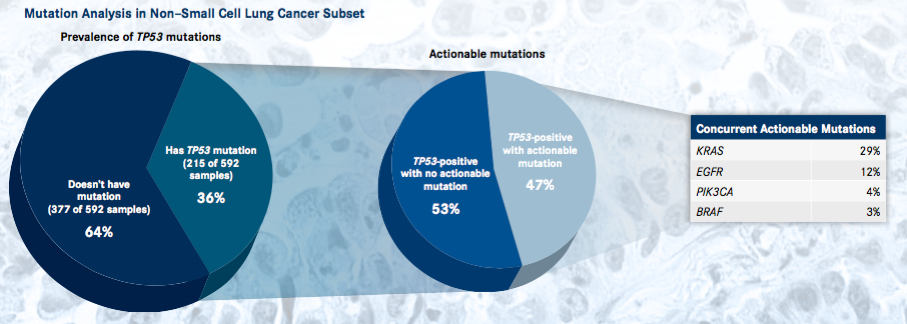TP53 Mutations Loom Large in Lung Cancer Study
Although there are no drugs that target TP53 mutations in any tumor type, a recent analysis of a non–small cell lung cancer sample set raises the prospect that a more detailed understanding of this aberration eventually could help direct therapy.
Zahra Shajani-Yi, PhD
Although there are no drugs that target TP53 mutations in any tumor type, a recent analysis of a non—small cell lung cancer (NSCLC) sample set raises the prospect that a more detailed understanding of this aberration eventually could help direct therapy.
Researchers determined that approximately 36% of samples from 592 patients with NSCLC harbored a somatic TP53 mutation, and that nearly half of those mutations coexisted with currently actionable molecular alterations, according to results presented at the 2016 American Association of Clinical Chemistry (AACC) Annual Meeting. The conference was held July 31-August 4 in Philadelphia.
“TP53 mutations are known to convey resistance to therapy, so we feel this type of data can potentially help personalize treatment. If we know that the therapy might be more difficult, we can tailor it a little bit differently,” said Zahra Shajani-Yi, PhD, a clinical chemistry fellow in the Department of Pathology and Laboratory Medicine at Dartmouth-Hitchcock Medical Center and the Geisel School of Medicine at Dartmouth in New Hampshire.
The mutation has been the focus of “intense” drug development efforts including current studies of gene therapies that would restore the function of p53 proteins, Shajani-Yi and colleagues said in their conference poster.
“For this reason, the identification of both the particular TP53 mutation and concurrent known actionable genes present in the tumor could lead to appropriate treatment and improved clinical outcomes for the patient,” they said.
The Dartmouth-Hitchcock analysis represents one of the largest studies of individual TP53 mutations conducted thus far in NSCLC, the team indicated. TP53, the most frequently mutated gene in human cancer, encodes the p53 DNA-binding transcription factor that, in turn, regulates multiple DNA repair genes and several hallmark processes of cancer, the researchers said.
TP53 has historically been considered a tumor suppressor gene that promotes cancer when it loses this function through mutation. The gene, however, also has “oncogenic properties that promote invasion, metastasis, proliferation, and cell survival,” investigators said in their poster.
“We should no longer be thinking in a binary way about a tumor being TP53 positive or negative, but rather what the TP53 mutation is,” Shajani-Yi said in an interview with OncLive.
In the study, DNA was extracted from formalin-fixed, paraffin-embedded surgical and cytology specimens from 592 adenocarcinoma or poorly differentiated carcinoma NSCLC tumors collected for molecular testing between 2013 and 2016. Next- generation sequencing was conducted using an Ion Torrent cancer 50-gene mutation testing panel.
The results revealed the complexity of TP53 mutations. In all, 215 of the samples (36.3%) had ≥1 mutation in TP53 and, of those, 140 were unique mutations. “The mutations ended being spread across the entire region, which makes it hard to target in terms of designing drugs,” said Shajani-Yi.
Eleven percent of the TP53 aberrations occurred in 6 “hotspots,” or single point mutations: R175, G245, R248, R249, R273, and R282. However, the 2 most common mutations were not found among the hotspots; instead, mutations in V157F (also known as R157F) and R158L were most frequently measured at 3% each of the TP53-positive samples.

Breaking the samples down still further, investigators then sought to determine whether the TP53-positive samples also harbored a mutation in the actionable NSCLC genes KRAS, EGFR, BRAF, and PIK3CA.
Among the TP53-positive samples, 47% also had a mutation in 1 of those 4 key genes. The frequency of actionable mutations in this subset was 29% for KRAS mutations, 12% for EGFR, 4% for PIK3CA, and 3% for BRAF.
The next steps for the research include analyzing TP53 mutations in other cancer types from a databank of samples collected from approximately 1700 patients with different solid tumors, Shajani-Yi said.
Although this knowledge would not immediately translate into clinical practice, it contributes to the information about TP53 mutations that could eventually be useful in recommending first-line therapies, the research team believes.
“We are not there yet for TP53,” Shajani-Yi said. “The hope is that one day we could be.”
Shajani-Yi Z, deAbreu FB, Peterson JD, Tsongalis GJ. Frequency of somatic TP53 mutations in combination with known pathogenic mutations in non-small cell lung carcinoma as identified by next-generation sequencing. Poster presented at: 68th AACC Annual Scientific Meeting & Clinical Lab Expo; July 31-August 4, 2016; Philadelphia, PA. Poster A-055.